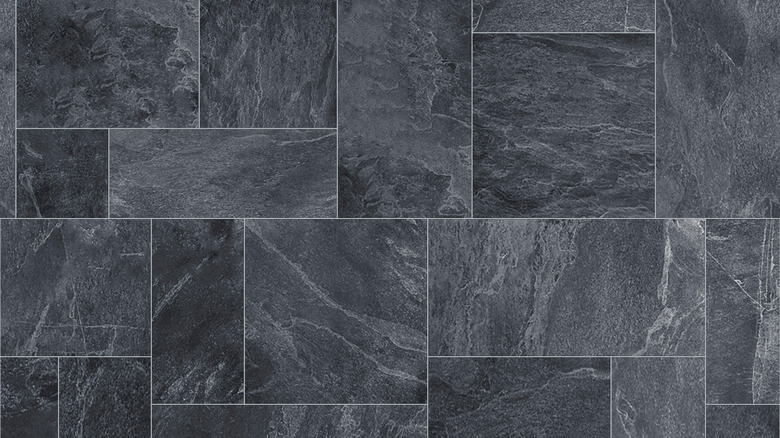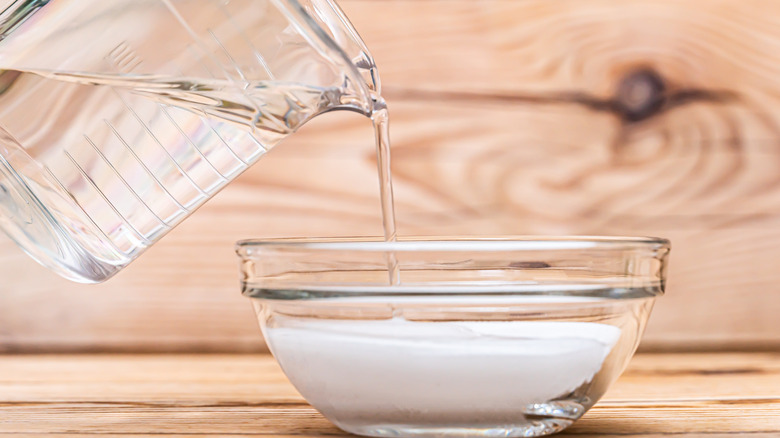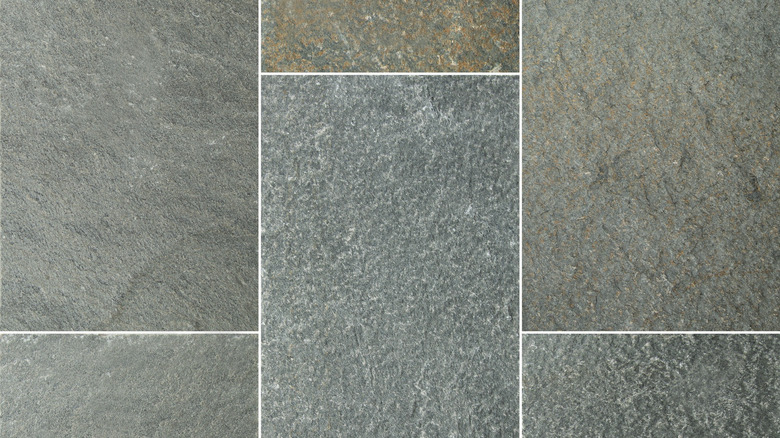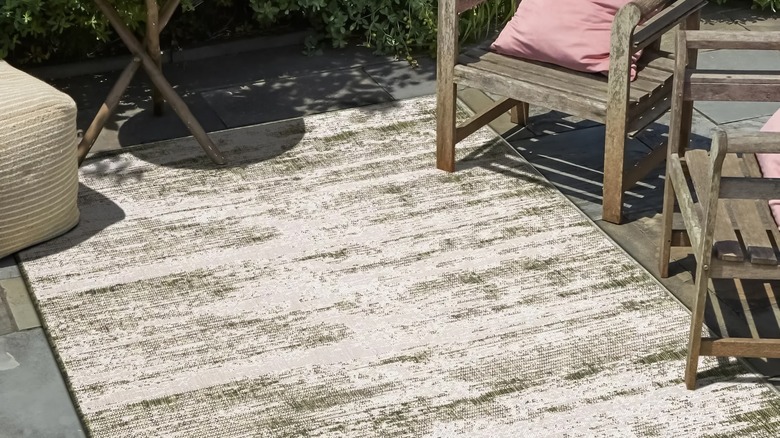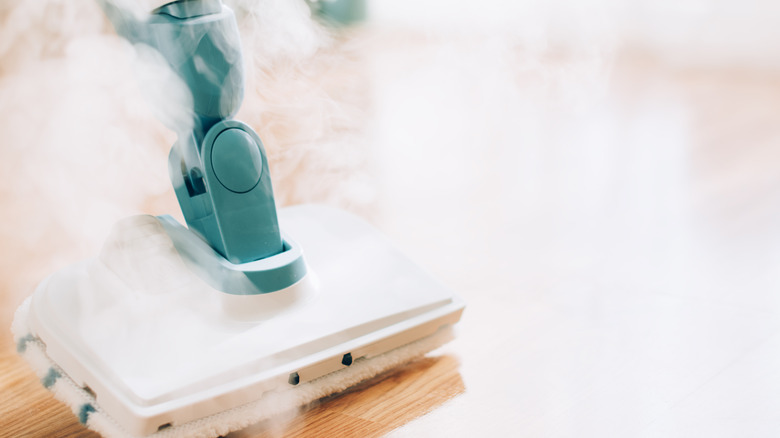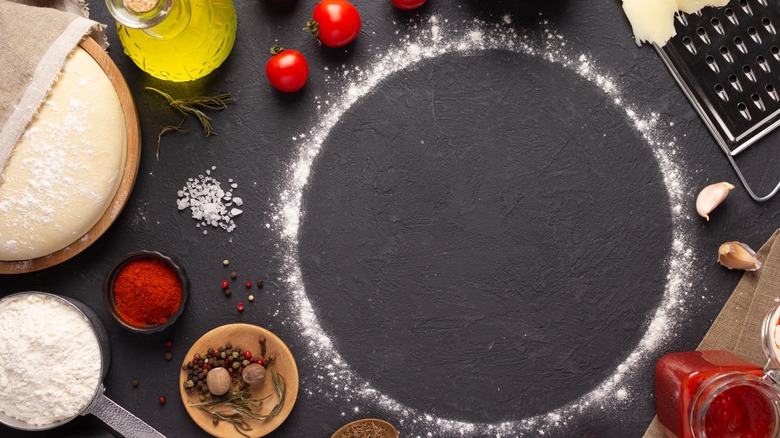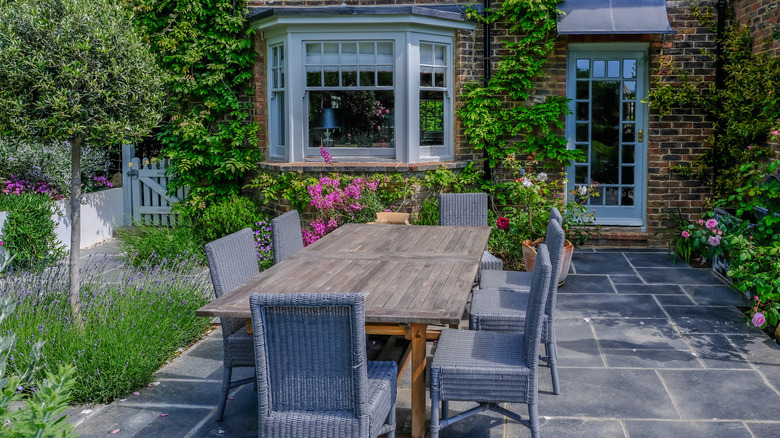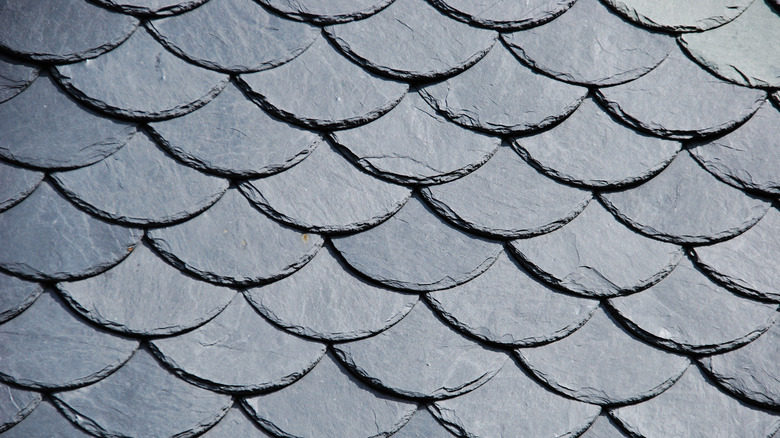The Best Way To Clean Slate
Slate is a beautiful natural stone. According to Floor Coverings International, it is one of the most budget-friendly options for those looking for natural stone floors. It offers several other benefits, including its durability and water-resistant capabilities. Moreover, the stone is attractive and can add visual appeal to your home. While flooring is one of the most popular uses for slate in a home, Southland Stone USA notes that it is a very versatile material that can also be used for countertops, fireplace hearths, roofs, and more.
With its rough texture and natural design variations, slate does better than other types of flooring at hiding dirt or damage. And when it's time to clean it, it's much easier to do so than other natural stones, such as granite or marble. However, it is still important to know the best way to clean slate to keep it looking its best and avoid causing any damage. Here's how.
Daily care for slate floors
Keeping up with a regular cleaning schedule will help keep your slate floor looking its best and protect it from damage. Slate floors should be swept every day. This will remove any debris that could potentially scratch the surface. MSI Surfaces explains that daily sweeping is even more important in the first few months after you've had a new slate floor installed. Before the tiles have finished spalling, a few small flakes may loosen and be present on the surface. While this is a completely normal process, you'll want to sweep up the jagged pieces so that they don't leave any scratch marks.
When a deeper clean is necessary, only use pH-neutral cleaners designed for natural stone floors. These will help prevent the floor from becoming damaged or accidentally stained. After cleaning the floors, mop over them again using plain water to rinse any residue away. Then, allow the surface to air dry. If preferred, you can speed up the drying process using a microfiber cloth.
Removing oil stains from slate floors
There may be times when you need to give your floors a little more attention, such as removing oil stains. How to Clean Stuff shares that slate's porosity can allow oil to penetrate the stone. This will leave behind a stain that will not come off with water or a standard floor cleaner.
Fortunately, you can remove oil stains with just a few ingredients and a few minutes of your time. The first step is to use an absorbent material — such as cornstarch, baking soda, or cat litter — and sprinkle it over the stain. Thoroughly cover the stain and leave it to sit so it can absorb the oil. Spots that have been on the floor for a while should remain covered overnight, while newer blotches may only need about 10 minutes to be absorbed by the powder of your choice.
After the recommended time has passed, use a vacuum or broom to clean up the absorbent material you used. If the stain is still present, repeat the steps above or make a baking soda paste to leave over the blotch. Add a few drops of water to a bowl of baking soda (you want the mixture to be thick). Then, apply the paste on top of the stain. Let it dry fully, then clean up the powder.
For really persistent stains, apply a small amount of mineral spirits over the area. Let them sit for about 30 minutes, then rub the stain using a stiff brush. Soak up the mineral spirits using a rag, and rinse the area with water and dish soap.
Reseal your slate floor
According to Atlas Ceramics, it is essential to seal slate tile floors. Ideally, the tiles should be sealed before being laid and definitely before the grout is applied. If they are not, they can become damaged more easily. The tiles can start to show signs of wear, the finish may degrade, and they won't look as attractive in your home. Moreover, if slate tiles aren't sealed, they may become more slippery when wet. This could make any spills on the floor a potential hazard.
StoneImpressions shares that slate and other natural stone tiles should also be resealed periodically throughout their lifespan. If your floor is in a high-traffic area, applying new sealant approximately once a year is best. The heavier traffic on the stones causes the finish to degrade more quickly.
Slate floors with minimal traffic may not need to be sealed as frequently. Depending on how often you walk on that patch of flooring, you may be able to stretch the time between coats of sealants to a year and a half or more. Keep an eye on the finish or contact the company that installed the floors to get a better idea of the ideal timing.
Protecting your slate floor from stains and scratches
Sealing your slate floor about once every year is one way to protect it against stains and scratches. As Express Flooring shares, there are other measures you can take to protect your floors to extend their lifespan and keep them looking their best. Using area rugs and runners is one of the best ways to protect your floors from damage. Placing carpets along paths that are commonly walked over or areas where you'll be standing for long periods of time — such as in front of the sink or stove — will limit the direct wear on the floor. Area rugs also offer the additional benefit of providing more cushioning and keeping your feet warmer.
Another way to protect your floors against scuffs and scratches is to carry furniture items around the room, not push them. Beyond the scratches it could leave behind, a heavier piece of furniture could also potentially crack one of the slate tiles. If you have a slate floor in a room with a dining table, place protective covers over the chair legs to keep them from causing damage as they are pushed into or out of the table.
It is also important to make sure that spills are promptly cleaned up. The liquid can damage the sealant if it isn't wiped right away. This could impact the overall durability of the tiles and make it more likely that they'll absorb future spills.
Cleaning methods to avoid with slate floors
As mentioned earlier, slate is a natural stone. While it is known for its durability, it can still be damaged if the wrong cleaning methods are used. Classic Marble & Stone Restoration shares that steam cleaners should not be used to clean natural stone floors. The high heat expelled by them can lead to several potential problems. First, when you steam clean a slate floor, it can remove the sealant. Without the sealant, the stone won't be as protected against damage or staining. Also, when you blast stone tiles with steam, they will also expand and contract as they are exposed to heat. This can cause a buildup of pressure inside the stone, which may cause the surface to flake. The increased pressure can also cause tiny cracks in the tiles to become larger.
The North American Tile Cleaning Organization shares that you should never use steel wool or other abrasive cleaners on slate floors. These types of cleaners can leave behind scratches or damage the finish of the floor or sealant. Similarly, acidic cleaners, like vinegar or lemon, should also never be used to clean this type of flooring. KleanStone notes that acidic cleaners work by creating a chemical reaction, which can remove the sealant or even cause etching in the surface of the slate tiles.
Cleaning slate countertops
Slate countertops are attractive, durable, and stain-resistant. According to Granite Gold, this type of stone countertop is often designed with a natural-cleft finish, making it easier to maintain than some other stone types. However, as with your slate floors, you'll want to be careful when cleaning these countertops. Never use abrasive or acidic cleaners on the counters. These cleaners may break down the seal on the counter and damage the stone's finish. Instead, look for pH-balanced cleaners specifically designed for use on natural stone.
One of the most important things you can do to keep a slate countertop looking its best is to keep it dry. Spills of food or beverages should be cleaned up promptly to avoid staining the stone. If the countertop does get stained, act quickly to clean it up. Baking soda can also work well to absorb greasy or oily stains on the countertop. Mix it with a bit of acetone, apply it over the stain, and let it sit for a full day. Then, wipe up the residue and rinse the countertops. If necessary, these steps can be repeated.
For non-grease stains that create a discoloration (like wine or coffee,) use a 50/50 mixture of water and laundry bleach. Add the solution to a spray bottle and apply it directly over the stain. Use a non-abrasive sponge to scrub the countertops, and leave the solution sitting for about 15 minutes. Then, thoroughly rinse the area and apply a new sealant to protect the countertops.
Cleaning a slate fireplace hearth
Slate is also a popular material for fireplace hearths and surrounds. As with other surfaces, using the right cleaning products is essential for protecting the finish and maintaining your fireplace's beauty. FireplaceMall explains that dust, soot, and other debris should be removed from the fireplace on a regular basis. A vacuum, broom, or dusting cloth can also be used for this step. Complete each regular cleaning session by cleaning the slate with a solution of water and dish detergent. Add the water and a few drops of the detergent and mix to combine. Then, dip a soft cloth into the solution and wipe the entire surface. Fill the bucket with clean water, and wipe the surface again to remove any soapy residue. Finally, use a dry cloth to remove as much moisture as possible from the stone.
When a deep cleaning is needed, look for a cleaner specifically designed for use with slate fireplaces. Each manufacturer may have different recommendations, so be sure to read and follow the instructions on the label. After cleaning according to the label, you can apply a thin coat of teak oil to protect the stone and improve its shine.
Cleaning a slate patio
Clever Patio recommends sweeping and mopping the surface of a slate patio to remove dust and grime before attempting to give it a deeper cleaning. Then, you can add a few drops of mild dish soap to a bucket of warm water and use a brush to scrub the surface with the solution. Be sure to use a stiff brush to get rid of tough stains. Once you've finished scrubbing, rinse the surface using clean water to get rid of any residue. Give the stone time to dry, and apply a fresh coat of sealer to protect the finish.
If there are any stains left behind after cleaning the patio, hold off on applying the sealer. Use hydrogen peroxide mixed with water (1:1 ratio) and spray it over the stains. Leave it to set for about 10 minutes, then use a soft-bristled brush to scrub the patio tiles.
While you can clean a slate patio with a power washer, doing so may not be the best choice. The pressure from the nozzle may damage the stone or the sealant's finish. Steam may also be used on patios. However, as mentioned above, the heat may cause the stones to expand and contract, which can lead to cracks or other damage.
Cleaning a slate roof
A slate roof can upgrade the look of a home. It is a highly durable and long-lasting material that can often outperform a shingle roof. Generally speaking, slate roofs are easy to maintain. According to Yates & Co., the cleaning required is minimal.
Keeping the roof free of leaves, moss, and other debris will help protect the stone and allow it to maintain its attractive appearance. Much of this debris can simply be blown off of the roof. However, if you're dealing with mold, rust, or anything stuck on, you'll need to use some elbow grease to scrub the stone. Choose a cleaning product designed for slate roofs, or make your own using mild dish soap and water. After scrubbing the stone, gently spray the roof with your garden hose to get rid of any soapy residue.
Before cleaning, take note that you cannot simply walk across a slate roof as you can on one covered with shingles. The stone can become slippery and can also break if stepped on wrong. If you lay an extension ladder across the roof, you'll be able to move along it to help you reach the various areas that need to be cleaned.

